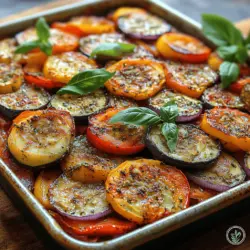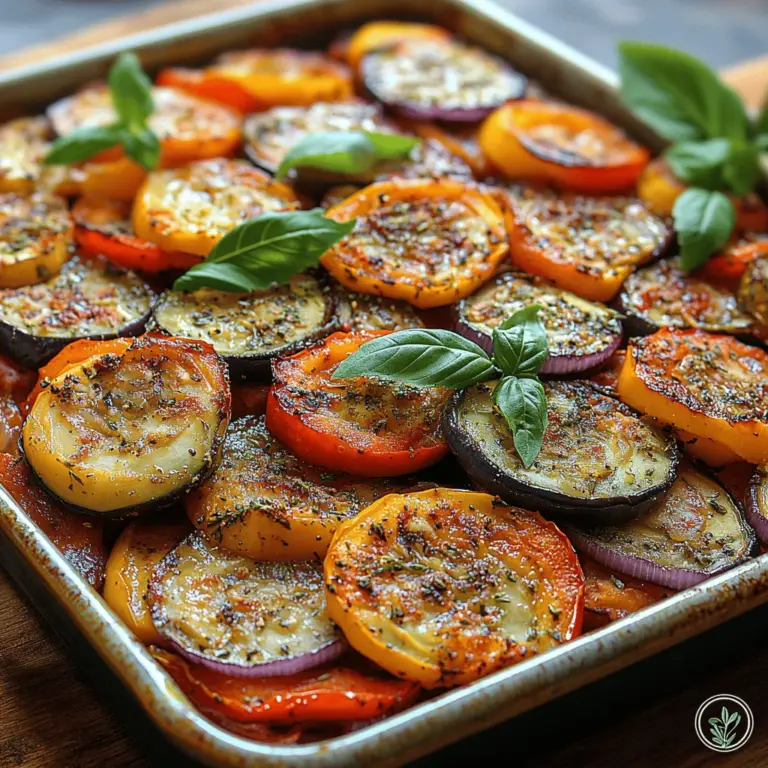Introduction
Baked Summer Ratatouille is a vibrant dish that captures the essence of the summer harvest, showcasing a delightful medley of fresh vegetables. This rustic French recipe is not only a feast for the eyes with its colorful presentation but also a celebration of wholesome ingredients that offer a wealth of health benefits. Originating from the sun-kissed region of Provence, ratatouille has evolved from a peasant dish into a beloved staple in kitchens around the world.
As summer vegetables reach their peak freshness, this dish stands out for its versatility, allowing you to serve it as a side dish, a light main course, or even a filling addition to salads and sandwiches. In this article, we will delve into the origins of ratatouille, explore the nutritional value of its key ingredients, and provide a detailed step-by-step guide on how to prepare this delicious dish. Whether you’re hosting a summer gathering or simply looking to enjoy the bounty of the season, this baked summer ratatouille is sure to impress your family and friends.
Understanding Ratatouille: A Culinary Tradition
The origins of ratatouille can be traced back to the rustic kitchens of Provence, where farmers sought to make the most of their summer harvests. The word “ratatouille” itself is derived from the French verb “touiller,” which means to stir, reflecting the dish’s humble beginnings as a mix of seasonal vegetables. Traditionally, ratatouille was a way to utilize surplus produce, particularly eggplant, zucchini, and peppers, ensuring that nothing went to waste.
As time passed, ratatouille evolved from a practical solution for excess vegetables into a celebrated culinary tradition. The dish is often associated with the vibrant colors and rich flavors of the Mediterranean. While there are many variations of ratatouille, the common thread is the emphasis on fresh, high-quality ingredients that reflect the season’s best offerings.
In recent years, ratatouille has gained popularity in various culinary circles, with chefs and home cooks alike experimenting with different cooking methods and flavor combinations. Baked Summer Ratatouille, in particular, showcases the natural sweetness of the vegetables, enhanced by the roasting process that deepens flavors and creates a satisfying texture. This approach not only highlights the beauty of the ingredients but also allows for a healthier preparation method compared to traditional frying.
Nutritional Benefits of Baked Summer Ratatouille
One of the many reasons to love Baked Summer Ratatouille is its incredible nutritional profile. Each ingredient contributes to the dish’s health benefits, making it a delicious choice for those seeking to maintain a balanced diet. Let’s take a closer look at the nutritional value of the key components that make up this colorful dish:
– Eggplant: This versatile vegetable is rich in antioxidants, particularly nasunin, which is known for its anti-inflammatory properties. Eggplants are also high in dietary fiber, promoting healthy digestion and aiding in heart health.
– Zucchini and Summer Squash: Both zucchini and summer squash are low in calories, making them excellent choices for weight management. They are loaded with vitamins A and C, which support skin health and boost the immune system. Additionally, their high water content helps keep you hydrated during the warmer months.
– Bell Peppers: Available in various colors, bell peppers are excellent sources of vitamin C, which is vital for immune function and skin health. They also contain a variety of antioxidants that can help reduce inflammation and protect against chronic diseases.
– Tomatoes: One of the star ingredients in ratatouille, tomatoes are packed with lycopene, a powerful antioxidant linked to heart health and cancer prevention. They are also a great source of vitamins A and C, which contribute to overall wellness.
– Garlic and Onions: Both garlic and onions are known for their health benefits, including anti-inflammatory properties and potential cancer-fighting benefits. Garlic, in particular, is recognized for its ability to support heart health and boost the immune system.
– Olive Oil: A cornerstone of Mediterranean cuisine, olive oil is rich in monounsaturated fats, which are beneficial for heart health. It is also packed with antioxidants and has anti-inflammatory properties, making it a healthy fat choice for cooking.
With such an impressive array of health benefits, Baked Summer Ratatouille is not just a delicious dish; it’s a nutritious option that can easily fit into any balanced diet.
Gathering Your Ingredients for Baked Summer Ratatouille
To prepare a delightful Baked Summer Ratatouille, you’ll need to gather a selection of fresh ingredients that embody the flavors of summer. Here’s a comprehensive list of what you’ll need for this recipe:
– Eggplant: Look for firm, glossy eggplants, which will have the best flavor and texture.
– Zucchini: Choose young zucchini that are small to medium-sized for the best taste and tenderness.
– Yellow Summer Squash: Similar to zucchini, fresh yellow squash adds a lovely color and flavor to the dish.
– Red and Yellow Bell Peppers: Opt for vibrant, crisp bell peppers to enhance the visual appeal and flavor of the ratatouille.
– Onion: A medium-sized onion will provide a lovely base flavor for the dish.
– Garlic: Fresh garlic cloves will add depth and aroma to the ratatouille, enhancing the overall flavor profile.
In addition to these primary ingredients, you may want to have some fresh herbs on hand, such as thyme or basil, to garnish the dish for added flavor and freshness. With everything prepared, you’re ready to embark on the journey of creating this vibrant and nutritious Baked Summer Ratatouille.
Next, we will walk through the step-by-step process of preparing this delightful dish, ensuring that you achieve the perfect balance of flavors and textures.
{{image_2}}
Baked Summer Ratatouille Recipe
Ingredients
– Ripe tomatoes
– Extra-virgin olive oil
– Dried herbs: thyme and oregano
– Sea salt and black pepper
– Fresh basil for garnish
Step-by-Step Instructions for Perfect Ratatouille
To create a delicious Baked Summer Ratatouille, following detailed instructions is crucial for achieving the best flavor and texture. Here’s a comprehensive guide to help you through each step.
Preheat the Oven
Begin by preheating your oven to 375°F (190°C). Preheating is an essential step in baking, as it ensures that your vegetables begin cooking as soon as they enter the oven. This temperature is ideal for roasting vegetables, allowing them to caramelize beautifully while retaining their natural flavors.
Prepare the Vegetables
Next, prepare your vegetables for the ratatouille. You will need to wash and dry your zucchini, eggplant, bell peppers, and tomatoes thoroughly. For even cooking and optimal texture, cut the vegetables into uniform slices. Aim for approximately 1/4 inch thick slices.
1. Zucchini and Eggplant: Slice into rounds. If using eggplant, consider salting the slices for about 30 minutes to draw out excess moisture and bitterness. Rinse and pat dry before using.
2. Bell Peppers: Cut in half, remove the seeds, and slice into thin strips.
3. Tomatoes: Core and slice into rounds.
Uniformity in size helps ensure that all the vegetables cook evenly, preventing some from becoming mushy while others remain undercooked.
Seasoning
Now it’s time to season the vegetables. Drizzle a generous amount of extra-virgin olive oil over the sliced vegetables. This not only adds flavor but also helps them roast beautifully. For a balanced flavor profile, sprinkle dried thyme and oregano across the vegetables. Use sea salt and freshly ground black pepper to taste. Toss everything gently to ensure that each slice is evenly coated with the seasoning.
Layering in the Baking Dish
Layering is key to achieving the perfect baked ratatouille. In a large baking dish, start with a base layer of tomato slices, creating a foundation for the other vegetables. Then, alternate layers of zucchini, eggplant, bell peppers, and more tomatoes, arranging them in a beautiful, overlapping pattern. This not only looks stunning but also allows flavors to meld as they cook.
To make the presentation even more appealing, consider arranging the vegetables in a circular pattern or in rows. The goal is to create a visually stunning dish that invites your guests to dig in.
Baking Process
Cover the baking dish with aluminum foil and place it in the preheated oven. Baking covered will help steam the vegetables, ensuring they are tender. After about 30 minutes, remove the foil to allow the top layer to caramelize. This will take an additional 20-30 minutes. Keep an eye on the ratatouille; it should be bubbling and lightly browned on top when done.
Understanding the significance of this step is essential: the uncovered baking allows for a delightful texture contrast between the tender vegetables and the slightly charred edges, enhancing the overall flavor profile.
Garnishing and Serving
Once your ratatouille is out of the oven, let it cool for a few minutes before garnishing. Fresh basil leaves add a burst of flavor and a pop of color. Simply tear the basil leaves and sprinkle them over the dish before serving.
Baked Summer Ratatouille can be enjoyed warm or at room temperature. For serving suggestions, consider pairing it with a protein like grilled chicken, fish, or a hearty grain such as quinoa or couscous. It also pairs beautifully with crusty bread or over pasta for a comforting meal.
Exploring Variations of Ratatouille
While the classic Baked Summer Ratatouille is a delicious representation of the dish, there are many ways to adapt it to suit your preferences and needs.
Adding Protein
For a heartier meal, consider incorporating protein into your ratatouille. You can add cooked chicken, diced tofu, or legumes like chickpeas or lentils. Simply mix them into the vegetable layers before baking, or serve alongside the ratatouille for a balanced dish.
Herb Substitutions
While dried thyme and oregano are traditional choices, feel free to experiment with different herbs. Fresh herbs can add an extra layer of flavor. Consider using fresh thyme, rosemary, or even a pinch of dill. You might find that fresh herbs provide a brighter taste, particularly during the summer months when they are at their peak.
Spicy Ratatouille
If you enjoy a bit of heat, spice up your ratatouille by adding red pepper flakes or diced jalapeños. You can mix these spicy elements into the vegetable layers before baking for an added kick that complements the dish’s natural sweetness.
The Cultural Significance of Ratatouille
Ratatouille is not only a dish but also a cultural icon within French cuisine. Originating from the Provence region, it represents the essence of summer through its use of fresh, seasonal vegetables. The dish is celebrated for its rustic roots and the way it showcases the flavors of the Mediterranean.
In popular culture, ratatouille gained worldwide fame through the 2007 animated film of the same name. The film tells the story of a rat named Remy who dreams of becoming a chef in Paris. This portrayal has elevated ratatouille to a symbol of culinary aspiration and creativity, inspiring both home cooks and professional chefs alike.
Conclusion
Baked Summer Ratatouille is more than just a dish; it represents a celebration of summer’s harvest and the joy of cooking with fresh ingredients. Its rich history, nutritional benefits, and versatility make it a staple in many kitchens. Whether enjoyed as a main course or a side dish, this ratatouille is sure to bring warmth and color to your table, reminding us of the simple pleasures of good food.
By following this detailed recipe and exploring various adaptations, you can savor the flavors of summer in every bite. So gather your fresh vegetables, preheat the oven, and embark on a culinary journey that honors the essence of seasonal cooking. Enjoy your ratatouille with family and friends, and let it be a dish that brings everyone together around the table.


